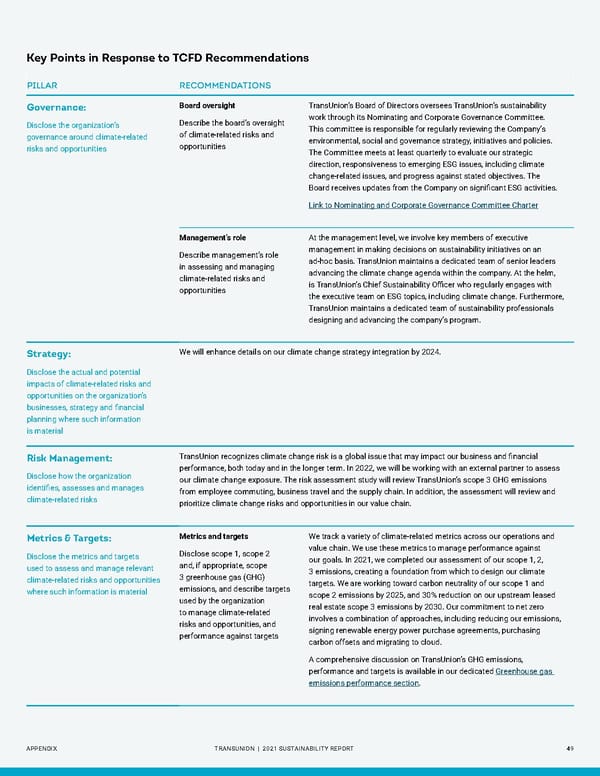Key Points in Response to TCFD Recommendations PILLAR RECOMMENDATIONS Governance: Board oversight TransUnion’s Board of Directors oversees TransUnion’s sustainability Describe the board’s oversight work through its Nominating and Corporate Governance Committee. Disclose the organization’s This committee is responsible for regularly reviewing the Company’s governance around climate-related of climate-related risks and environmental, social and governance strategy, initiatives and policies. risks and opportunities opportunities The Committee meets at least quarterly to evaluate our strategic direction, responsiveness to emerging ESG issues, including climate change-related issues, and progress against stated objectives. The Board receives updates from the Company on significant ESG activities. Link to Nominating and Corporate Governance Committee Charter Management’s role At the management level, we involve key members of executive Describe management’s role management in making decisions on sustainability initiatives on an in assessing and managing ad-hoc basis. TransUnion maintains a dedicated team of senior leaders climate-related risks and advancing the climate change agenda within the company. At the helm, opportunities is TransUnion’s Chief Sustainability Officer who regularly engages with the executive team on ESG topics, including climate change. Furthermore, TransUnion maintains a dedicated team of sustainability professionals designing and advancing the company’s program. Strategy: We will enhance details on our climate change strategy integration by 2024. Disclose the actual and potential impacts of climate-related risks and opportunities on the organization’s businesses, strategy and financial planning where such information is material Risk Management: TransUnion recognizes climate change risk is a global issue that may impact our business and financial performance, both today and in the longer term. In 2022, we will be working with an external partner to assess Disclose how the organization our climate change exposure. The risk assessment study will review TransUnion’s scope 3 GHG emissions identifies, assesses and manages from employee commuting, business travel and the supply chain. In addition, the assessment will review and climate-related risks prioritize climate change risks and opportunities in our value chain. Metrics & Targets: Metrics and targets We track a variety of climate-related metrics across our operations and Disclose scope 1, scope 2 value chain. We use these metrics to manage performance against Disclose the metrics and targets our goals. In 2021, we completed our assessment of our scope 1, 2, used to assess and manage relevant and, if appropriate, scope 3 emissions, creating a foundation from which to design our climate climate-related risks and opportunities 3 greenhouse gas (GHG) targets. We are working toward carbon neutrality of our scope 1 and where such information is material emissions, and describe targets scope 2 emissions by 2025, and 30% reduction on our upstream leased used by the organization real estate scope 3 emissions by 2030. Our commitment to net zero to manage climate-related involves a combination of approaches, including reducing our emissions, risks and opportunities, and signing renewable energy power purchase agreements, purchasing performance against targets carbon offsets and migrating to cloud. A comprehensive discussion on TransUnion’s GHG emissions, performance and targets is available in our dedicated Greenhouse gas emissions performance section. APPENDIX TRANSUNION | 2021 SUSTAINABILITY REPORT 49
 Sustainability Report | TransUnion Flipbook Page 48 Page 50
Sustainability Report | TransUnion Flipbook Page 48 Page 50